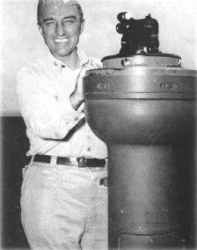
 |
|
|
||
|
Thomas Lamison Sprague |
||||
|
Graduate, U.S. Naval Academy, Class of 1917 Engagements: • World War I (1914 - 1918)• World War II (1941 - 1945) |
||||
| Biography: | ||||
|
Thomas Lamison Sprague Admiral, U.S. Navy Thomas Lamison Sprague was born on 2 October 1894 in Lima, OH. Sprague graduated from the U.S. Naval Academy in 1917. (Although no relation to Admiral Clifton "Ziggy" Sprague, the two both attended the Naval Academy and graduated with the same class.) He served aboard the protected cruiser USS Cleveland (C-19) assigned to the trans-Atlantic convoy from June 1917 until April 1918 and, after serving on shore duty for a brief period, Sprague assisted in the official commission of the destroyer USS Montgomery (DD-121) in July. As a member of the ship's anti-submarine patrol, Sprague would eventually come to command the Montgomery from January to November 1920.
Inter-War Years After participating in naval flight training at Naval Air Station Pensacola, Sprague served as a staff officer under Pacific Air Commander Admiral H.V. Butler from 1921-23. In 1926, Sprague was transferred to the battleship USS Maryland (BB-46) serving with Observation Squadron 1 for two years before being stationed at the Naval Air Station San Diego in 1928.
Between 1931-36, Sprague served as Commander of Scouting Squadron 6, Director of the Aeronautical Engine Laboratory at the Naval Aircraft Factory in Philadelphia, and Air Officer on board the carrier USS Saratoga (CV-3) before being reassigned as to Pensacola as Superintendent of Naval Air Training from 1937 to 1940. World War II Serving as Executive Officer on board the USS Ranger (CV-4) on the Neutrality Patrol in the Atlantic for a year, Sprague helped commission the escort carrier USS Charger (AVG-30) and commanded the vessel during training missions in the Chesapeake from February to December 1942. After staff duty from January to June 1943, Sprague commissioned the USS Intrepid (CV-11) in August, and commanded the aircraft carrier in raids against the Truk and Marshall Islands during the first two months of 1944.
Promoted to Rear Admiral in June, Sprague commanded Carrier Division 22 which covered the assault on Guam from July-August and Morotai in September. In command of Task Group 77.4 and Task Unit 77.4.1 ("Taffy 1") during the Battle of Leyte Gulf from 24-25 October, Sprague briefly commanded Pacific training carriers under Carrier Division 11, before leading Carrier Division 3 off Okinawa from April-June 1945. Commanded Task Force 38.1 during the final air operations against Japan by the war's end.
Post-War Service Sprague was named Deputy Chief, then Chief, of the Bureau of Naval Personnel in 1946 serving until his promotion to Vice Admiral in August 1949. Appointed Commander of the Pacific Fleet Air Force in October, Sprague held this post until his retirement. Upon his retirement in April 1952, he was advanced in rank to four-star Admiral. * * The Act of Congress of 4 March 1925, allowed Navy officers to be promoted one grade upon retirement if they had been specially commended for performance of duty in actual combat. These promotions were colloquially known as "tombstone promotions" because they conferred the prestige of the higher rank but not the additional retirement pay, so their only practical benefit was to allow recipients to engrave a loftier title on their business cards and tombstones. An Act of Congress on 23 February 1942, enabled tombstone promotions to three- and four-star grades. He briefly returned to active duty to negotiate with the Philippine government over the status of U.S. air bases in 1956. Medals and Awards Navy Cross Death Admiral Thomas Lamison Sprague died on 17 September 1972 at Chula Vista, CA. Burial place unknown. |
||||
| Honoree ID: 652 | Created by: MHOH | |||
Ribbons
Medals
Badges
Honoree Photos
 |  |  |
 |  |
 |


